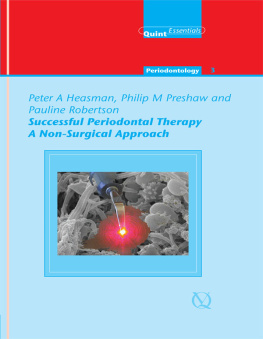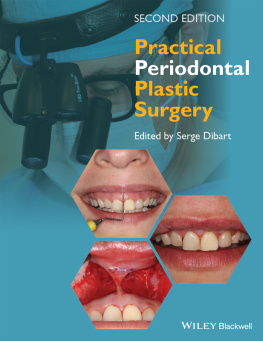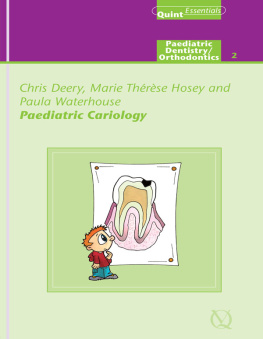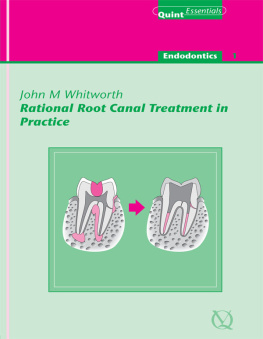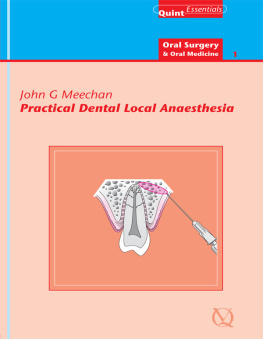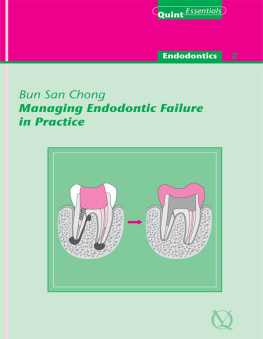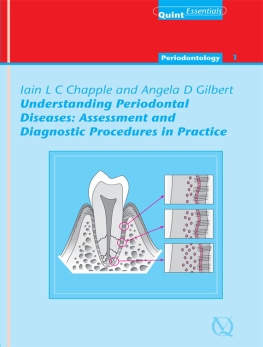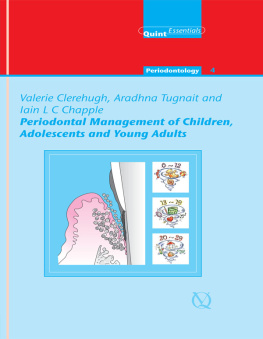
Quintessentials of Dental Practice 16
Periodontology 3
Successful Periodontal Therapy
A Non-Surgical Approach
Authors:
Peter A Heasman
Philip M Preshaw
Pauline Robertson
Editors:
Nairn H F Wilson
Iain L C Chapple

Quintessence Publishing Co. Ltd.
London, Berlin, Chicago, Copenhagen, Paris, Milan, Barcelona, Istanbul, So Paulo, Tokyo, New Dehli, Moscow, Prague, Warsaw
British Library Cataloguing in Publication Data
Heasman, Peter A.
Successful periodontal therapy : a non-surgical approach. - (Quintessentials of dental practice. Periodontology; 16. Periodontology; 3)
1. Periodontal disease - Treatment
I.Title II.Preshaw, Philip III.Robertson, Pauline
617.63206
ISBN 1850973156
Copyright 2004 Quintessence Publishing Co. Ltd., London
Figs 4-1, 4-3, 4-5 by Laura Andrew
All rights reserved. This book or any part thereof may not be reproduced, stored in a retrieval system, or transmitted in any form or by any means, electronic, mechanical, photocopying, or otherwise, without the written permission of the publisher.
ISBN 1-85097-315-6
Foreword
Successful periodontal therapy is, for many, fundamental to the goal of teeth for life. With a state-of-the-art non-surgicalapproach to periodontal therapy, success is dependent on a plethora of interrelated factors and influences, including thecomplexity of the disease process, predisposing risk factors, diagnostic skills and techniques, patient management and motivation,knowledge of modern instrumentation, techniques and adjunctive treatments, not to forget clinical acumen both during activetreatment and the equally critical long-term supportive periodontal care. Can all of this be covered effectively in a slim,easy-to-read book? Yes, it can: the authors of Volume 16, Periodontology 3 in the Quintessentials of Dental Practice Serieshave achieved this feat, with plenty extra packed in by way of a bonus.
It is proving to be a great learning experience being Editor-in-Chief of the Quintessentials of Dental Practice Series, thepresent book having added greatly to my new enlightenment. Dental students, trainee hygienists and therapists and practitionersof all ages, not to forget everyones patients, will benefit enormously from this timely contribution to the existing literature.I hope you enjoy and learn from this excellent book as much as I did.
Nairn Wilson
Editor-in-Chief
Preface
This text is the third of five books that aim to provide the general dental practitioner with an illustrated practical andcontemporary guide to the management of patients with gingival and periodontal diseases. This book is entitled Successful Periodontal Therapy: A Non-Surgical Approach. Initially it presents the reader with recognised goals and objectives of non-surgical treatment. Subsequent chapters coverthe clinical protocols and methods for achieving these goals: hygiene phase; scaling and root surface instrumentation; theinstruments used for scaling and root surface debridement; managing common and well-established risk-factors; and the useof treatments that are considered to be adjunctive to conventional methods of scaling and root surface instrumentation. Thefinal chapter reviews the importance of supportive periodontal care, which is highly relevant for general dental practitioners,for both those patients that they have treated in the primary care setting and those who may have received their non-surgicalmanagement by a specialist or in a hospital environment.
The Aim
It is hoped that having read this book on periodontal therapy the reader will be able to:
understand the healing events that follow non-surgical treatment
realise the limitations of non-surgical treatment
have knowledge of the range of mechanical and chemical products that are available to improve personal plaque control
be aware of the range of instruments that are available for removing tooth deposits
understand the importance of identifying and managing systemic and local risk factors for periodontal diseases
understand the importance of identifying and managing local anatomical and iatrogenic factors that may predispose to periodontaldisease
be aware of systemic and locally-delivered adjunctive treatments that are available and know how to reach informed decisionsregarding the most appropriate product for any specific clinical situation
understand the goals of supportive periodontal care and how they might be achieved
appreciate the need for patient compliance and understand how poor patient compliance might be identified and improved.
Peter Heasman
Philip Preshaw
Pauline Robertson
Iain Chapple
Acknowledgements
The authors would like to acknowledge with sincere thanks the following people: Janet Howarth of the Department of DentalPhotography at Newcastle Dental Hospital for her photographic expertise; Dr David Jacobs for Fig 5-1; Dr Shakil Shahdad forFigs 5-2 and 5-3; Dr Robert Wassell for Fig 5-5; Dr Dean Barker for Figs 5-8, 5-9 and 5-10; Dentsply UK for Figs 3-4, 3-6,3-7, 3-9, 3-10 and 3-14. We are grateful also to Professor Iain Chapple for Figs 3-15, 5-7 and 5-11 and Mrs Suzanne Noblefor use of Figs 3-16, 3-17 and 3-18. Permission has been granted to reproduce the following: Fig 2-4 (from Heasman, Millett,Chapple. The Periodontium and Orthodontics in Health and Disease. Oxford; Oxford University Press: 1996); Fig 5-5 (from Barnes, Walls. Gerodontology. Oxford; Wright: 1994); Fig 5-20 (from Heasman, Preshaw, Smith. Periodontology Colour Guide. London; Churchill Livingstone: 1997). Thanks to Iain Chapple and Damien Walmsley for the cover photograph and to George WarmanPublications, publishers of Dental Update, for permission to reprint part of this image.
Professor Heasman would like to acknowledge the support of Lynne, Sophie and Christopher, during the preparation of this book.Dr Preshaw would like to thank his wife, Sarah, for her help and support. Pauline Robertson would like to acknowledge thesupport of her husband, Brian, and family.
Chapter 1
The Goals and Clinical Outcomes of Non-Surgical Treatment
Aims
This chapter aims to outline the goals of non-surgical periodontal treatment and to provide an overview of the clinical outcomesthat are expected following treatment.
Outcome
After reading this chapter the practitioner should have an understanding of:
the healing events that follow non-surgical treatment
the magnitude of the clinical changes and outcomes expected following the hygiene (or initial) and instrumentation (or corrective) phases
the limitations of non-surgical treatment.
The Periodontal Pocket A Pathological Environment
A periodontal pocket is a pathologically deepened gingival crevice. The lateral and apical boundaries of the pocket are theulcerated epithelial lining of the pocket wall and the junctional epithelium respectively. The remaining wall of the defectcomprises the diseased root surface the target for periodontal treatment.
Next page
